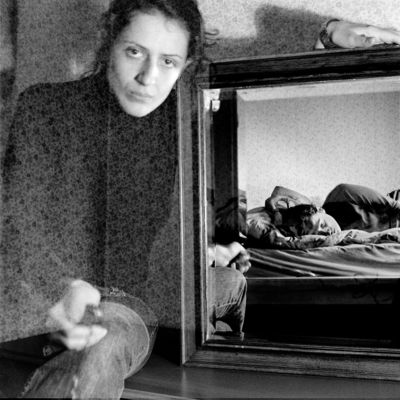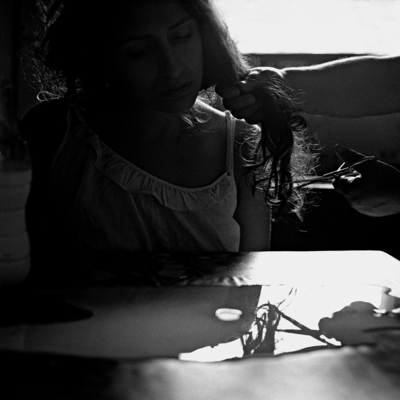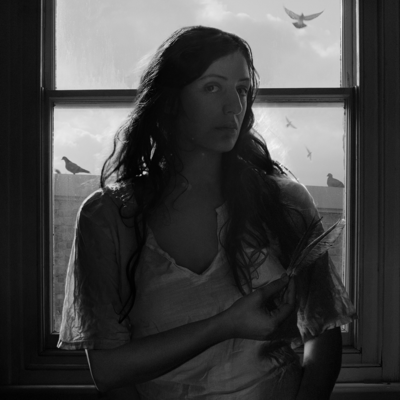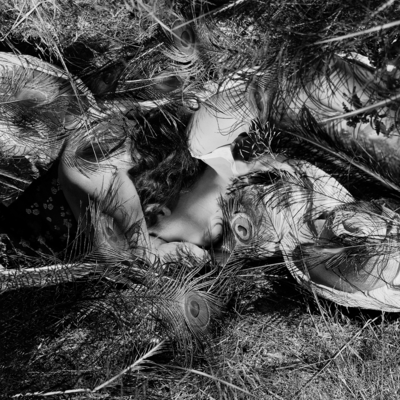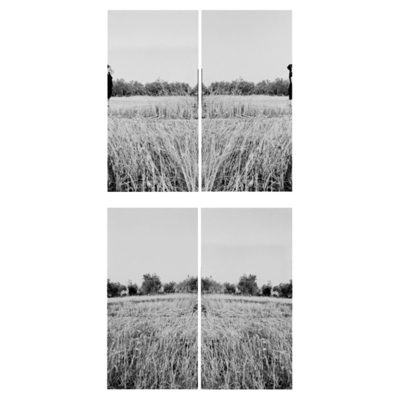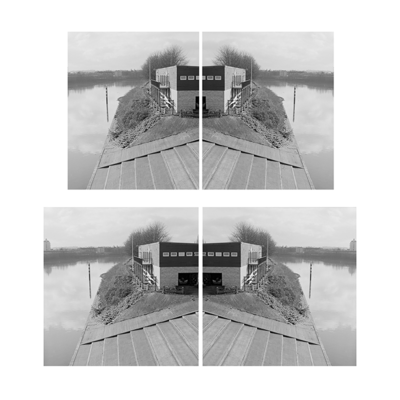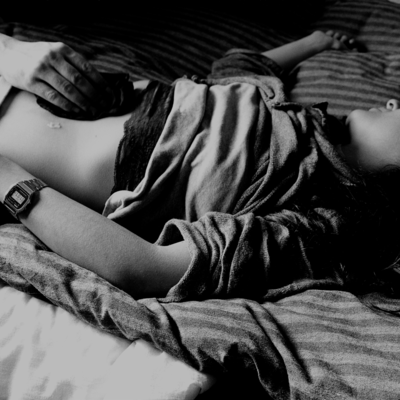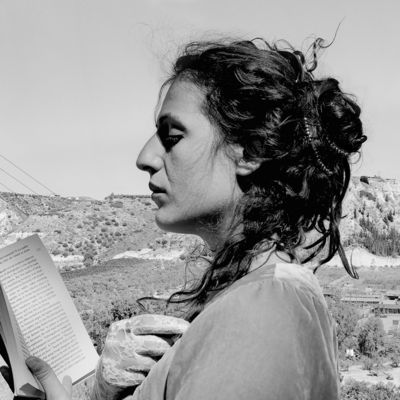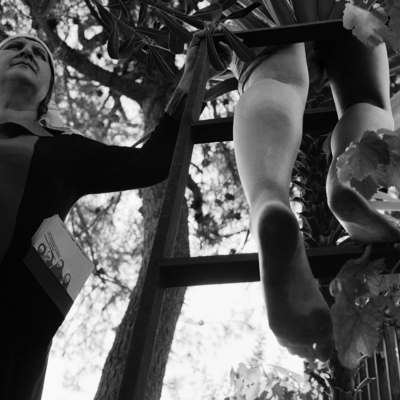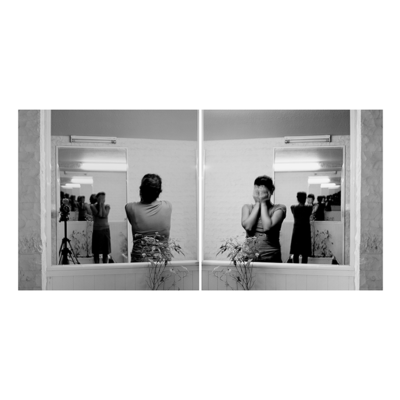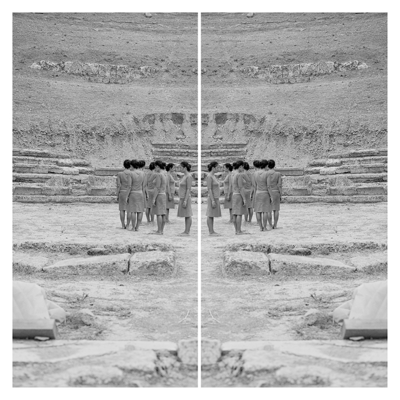No breath troubled the spring, where, peacefully reclining, all day long he contemplated his image … You know the story. But we tell it still. Everything has already been said; but since nobody listens, it must always be repeated.
(André Gide 1892 [1994: 45])
The images presented here conform to the genre of photographic self-portraiture and rely on combinations of ‘linguistic’ elements (symbols, references, text), structures, and geometries to present different aspects of narcissism.
The images deal with the excessive preoccupation with one’s own image and with narcissistic withdrawal, as well as with pleasures and structures of completeness relevant to narcissism. However, the approach varies in different images. For example, image 1 deals with narcissistic withdrawal in sleep and fantasies of bilocation relevant to autoscopy. Image 6 deals with self-idealisation with reference to Albrecht Dürer’s narcissism in Self-Portrait at the Age of Twenty-Eight (1500). Images 3, 6, and 7 deal with regression and idealisation, illustrating my narcissistic relationship to my mother.
Some images are more demanding for the viewer than others. For example, image 4 draws on Piero della Francesca’s profile portraits of Federico da Montefeltro and his wife Battista Sforza (1465–66) depicted in front of their territory. The figure in the image holds Susan Sontag’s book On Photography (readable in original dimensions) opened to page 111. This page includes Diane Arbus’s observation that a ‘photograph is a secret about a secret’ (Arbus in Sontag 1979: 111), among other ideas. The phrase in the image is half-concealed, allowing the viewer to read only part of the phrase (‘a photograph about a secret’). The text (in the book, in the image) operates as an embedded frame that forms a dialectical montage to comment on self-portraiture’s capacity to realistically represent one’s own self to him- or herself and introduce a contradiction between selfhood and ownership; furthermore, it possibly introduces a multiplicity of other meanings too, for example, linked to other parts of the text and the figure’s colonial outfit.
I also started working with the idea of narrative systems, highlighting their narcissistic structure through devices, such as the double and mise en abyme, rather than the artist’s narcissism/self-indulgence. At that stage it was important for me to use analogue methods of manipulating my images (e.g., multiple exposures, reduplications, and reversals), because I was interested in relating my practice to a photographic tradition of image construction that seemed to be dismissed in discussions about photography’s digitisation and its lost reference to the world. This was to argue that the questions underlying photographic self-portraiture, as well as the devices and themes used in it, have not changed, and that to resolve photographic self-portraiture’s contradictions we need to look elsewhere: the changed milieu of photography, and the misapprehension of the concepts of indexicality and narcissism when they are taken at face value.
On self-portraiture and narcissism
I was drawn to self-portraiture and photography’s intense projective power because of their potential to provide a fruitful ground for fiction – for example, as it occurs in the complex performances of Claude Cahun’s or August Strindberg’s photographic self-portraits. My interest in photographic self-portraiture was also focused on the genre’s connotations – that is, the artist’s narcissistic withdrawal and the projection of the artist’s ego onto the image, for self-interrogation or self-idealisation, despite the prohibitions of the artist’s conscience, photography’s self-consciousness in art, and the genre’s popularity. My main argument is that the relationship between self-portraiture and narcissism can be rationalised through psychoanalysis. But through this exploration narcissism revealed more than one facade and a few contradictions.
In psychoanalytic theory, narcissism emerges as a stage and a state (Freud 2001). Primary narcissism is a stage in infanthood associated with an absolute libidinal investment in the ego. Narcissism as a state re-emerges in adult life and carries both normative associations (i.e., as a therapeutic withdrawal during sleep, mourning, and organic disease) and pathological associations (in paraphrenia or hypochondria). Post-Freudian psychoanalysis reveals that narcissism is also involved in our relationship to objects, as in Melanie Klein’s concept of ‘projective identification’, according to which narcissistic relationships evolve from an early stage, starting with the infant’s relationship to the mother’s breast and expanding to any object that imaginarily substitutes the subject’s ego (Klein 1988). Narcissism can also be recognised in structures such as ‘the double’ and in doppelgänger encounters, which, in Sigmund Freud’s terms, are perceived as regressive threats because they remind us of primary narcissism (Freud 2003). In Lacan’s theory, the ‘imaginary’ is constructed via narcissism during the ‘mirror stage’ (Lacan 2002). Nevertheless, his concept of the object ‘petit a’, as evidenced by the example of a child looking at his brother on his mother’s breast, reveals immense emotional responses to structures of completeness and narcissistic relationships involving objects other than the subject him- or herself. Such structures are seen to be capable of raising the subject’s/viewer’s desire and envy (Lacan 2004: 116). Lacan (ibid.: 115) claims that ‘[i]nvidia comes from videre’, the Latin word for looking. His paragraph discussing the envy raised in the boy witnessing his brother on his mother’s breast is most revealing in terms of the function of the petit a in representation. He claims:
Such is true envy – the envy that makes the subject pale before the image of a completeness closed upon itself, before the idea that the petit a, the separated a from which he is hanging, may be for another the possession that gives satisfaction. (Ibid.: 116)
Lacan’s ideas are important because they derive from a seminar devoted to the function of pictures and the processes of art. As such, narcissism is seen also to operate within and through language, and to be much more involved in the processes of art than is evident in theories that deny the contribution of narcissism in the creation of original works.
All these different understandings of narcissism also inform the association between narcissism and visual work. Narcissism in its general cultural sense is most often associated with self-idealisation, which in self-portraiture is evident in the choice of subject matter and, often, also in the attempt to improve the artist’s appearance. These negative associations can be seen to prove that the viewer has overcome regressive threats, and is no longer affected by the uncanniness of the double.
Nevertheless, narcissism in its psychoanalytical sense can provide a useful interpretative framework for the understanding of, for example, Jo Spence’s and Hannah Wilke’s late work, which indicate a turn toward the self in a therapeutic gesture. Both artists’ works were made as responses to their experiences of cancer. Even though these works communicate via narcissism, they are oriented outward toward the viewer to convey ideas relevant to the artists’ experiences and the notion of personal/artistic identity and its construction. Works such as these highlight the complexity of narcissism, its function as an agency for social change, and its positive potential, not only for the individual but also for the broader whole. Narcissism in a metaphorical sense can also be seen as a valid vocabulary for individuals speaking from the margins, whether artistic or social.
Self-portraiture and its connotations are frequently employed in recent art photography, especially images that are obviously constructed to suggest a narrative and comment on earlier traditions in art. However, such self-conscious works seem to relate to a tradition of photographic self-portraiture that emerged historically, more as a solution to photography’s ‘authority consciousness’ than as an indication of any underlying psychological causes. Early photographers, such as Hippolyte Bayard and Oscar Gustave Rejlander, used self-portraiture to prove that their images were ‘made’ and not ‘captured’. Accordingly, recent self-portrait artists, such as Anna Gaskell or Anthony Goicolea, continue a legacy of ‘image-making’ and communicate with art audiences through an established vocabulary.
This distinction between unpremeditated and constructed responses to photographic self-portraiture is further amplified through the growing culture of the selfie, with camera phone photography now occupying a space equivalent to what was previously perceived as a more indexically loaded, amateur response to photography that became popular in art from the late seventies onward. In art photography, the centrality of narcissism in typical late twentieth-century views of photographic self-portraiture is consistently losing ground to systems of interpretation inherited from painting and the growing emphasis on the superficial use of the genre, while associations with narcissism persist in relation to Internet cultures of the selfie.
When the project began I was aiming to bring these contradictions centre stage, hoping that if I could bring the different facades of narcissism together I would then be able to decode the genre’s true nature.
Continue to next page >
